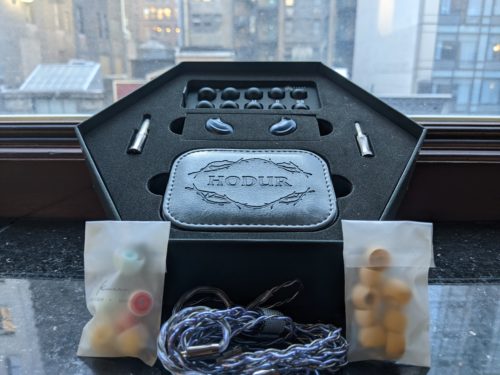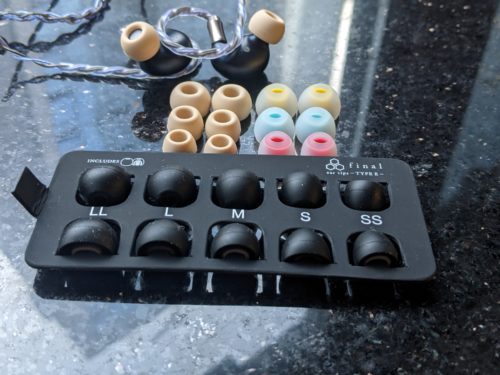Kinera Hodur Review
Today we’ll be going over a fairly recent in-ear monitor release from Linsoul’s Kinera: the Kinera Hodur. Though I don’t have a review to show for it, I’m not unfamiliar with Kinera’s IEMs. Their packaging makes them hard to miss, and frankly, it would be difficult to be in this line of work without having tried the Kinera Nanna at least once. In the context of the ever-increasing price tags on quality headphones and IEMs, I’m pleased to see that the Kinera Hodur is moderately affordable at $299. I was quite happy with the time I spent with Hodur, and for reasons that I’ll get into below, welcome it as an excellent option for those looking for a high-quality IEM that won’t completely empty their wallet.

What’s In The Box?
- Kinera Hodur IEMs
- 2 pin silver-plated copper IEM cable
- 3.5mm Unbalanced Jack
- 4.4mm Balanced Jack
- 5 Sets Final Audio Silicone Type E Tips
- 3 Sets K07 Silicone Tips
- 3 Sets K-285-02 Silicone Tips
- Hard Carrying Case
- Cleaning Tool
Look and Feel
I actually mostly have nice things in this department, so I’ll get the one hard part out of the way: the font and thorny branches decorating the carrying case are tacky and almost insulting to everything else the Hodur has to offer. Now, I can talk about what I liked.
The unit I received was a dark, steely blue, with “Kinera” and “Hodur” subtly engraved on the back of the left and right sides. Small additional aesthetic ridges on the back of the IEMs were filled in with a sparkly, black, graphite-like material, and gave them a dash of extra character. The silver-plated copper cable was a similar dark and sparkly silver-blue that naturally complimented the IEMs.
The fit was easily the best physical quality the Kinera Hodur had to offer. Though it didn’t reach very deeply into my ear canals, its light weight, thin depth, and smooth, rounded edges made it exceedingly comfortable to wear – what’s more, I never had to adjust it once I had it in my ears. It seems to be a truly universal fit, and I could easily get it securely into my ears with just one hand.
Though no foam is included in the ear tip selection, Kinera hooks it up with a wide variety of silicone tips of varying sizes. However, I tested some of my Dekoni foam tips on the Hodur and still found the experience similarly pleasant and ergonomic – in fact, I highly recommend it, as it resulted in a deeper fit that remained very comfortable.
Lastly, while I may not like the way the carrying case was decorated, it’s undeniably sturdy and is bound to provide ample protection for the IEM’s.

Design and Technical Specs
The Kinera Hodur has a 3-way crossover system that utilizes 3 drivers total: one dynamic for the lows and mids, a balanced armature for high mids, and an electrostatic for highs. This driver configuration is very similar to a favorite here at MajorHifi, ThieAudio’s Oracle MK2, which has a 1DD, 2BA, and 2EST configuration.
Drivers: 1 DD, 1 BA, 1 EST
Frequency Response: 5 Hz – 40 kHz
Impedance: 8 Ohms
Sensitivity: 106 dB
Sound Stage
The Kinera Hodur may have a smaller, more insulated soundstage, but it’s impressively fluid and dynamic. Height isn’t exactly its strong suit, but what impressed me was its ability to produce an angular listening experience with movement that fluidly wrapped from the front of my face and and bottom of my jaw back towards my ears. Depth was inconsistently present, but seemed to spring out when a mix demanded it. I did find a more convincing staging and imaging experience when using foam tips, but alas, it seems like Kinera is directing listeners towards silicone.
Overall, for a $300 IEM, it’s imaging abilities are pretty exciting and convincing, and provided adequate spatial separation.
Lows
The strong low end on the Kinera Hodur is pretty fun, if not the most detailed. Ample energy was given to throbbing kick drums, and electric basses found a little extra rumble and punch. The trade off for this emphasis was that these low end parts lost a little bit of their unique character, with the deep, demented sounding bass notes on “Summertime Clothes” by Animal Collective coming through powerfully but a bit generically. There are certainly times where I was appreciative of this handling of the low end, which could retain detail on tracks that weren’t particularly crowded – but busy mixes left the low end losing some definition in favor of a nondescript warm, bass energy.
Mids
The Kinera Hodur has a V-shaped frequency response – it attenuates its center mids while moderately accentuating low mids and high mids. Generally speaking, I was quite a fan of this mids balance. Low mids were present just enough to impart a little extra warmth on vocals and guitar fundamentals, but avoided muddying the balance. Boosted high mids kept guitars retaining a bright drive, and balanced out the low-mid fundamental boost on vocals with a little extra emphasis in their overtone fry. The only minor casualty to this balance were snare drums, which lost a little body and realism in the Hodur’s fairly gentle center-mid scoop.
Highs
Though my impression of the Kinera Hodur wasn’t what I would explicitly call “trebly,” it provides some exceptional high end detail. Upon some extended listening, I started to notice that reverbs were extra pronounced but avoided overemphasis. In a similar vein, vocal air also had a healthy presence, which provided a pleasant, contrasting synergy with the warmth provided to them in the mids balance. Same case for acoustic guitars: strummy transients sat well balanced with the lightly boosted low end guitar hum found in the low mids. Hi-hats and cymbals sounded natural, and ride cymbals had a healthy dose of their harmonic overtones present in their long decays. Overall, the high end seemed boosted just enough for some detailed layering without running into issues with sibilants, shrillness, or artificiality.
 Overall
Overall
At a time when audio manufacturers seem preoccupied with making more and more expensive in-ear monitors and headphones, it’s extremely refreshing to come across a $300 IEM that I can genuinely recommend for its clean balance and engaging imaging, not just for its relative affordability. Generally speaking, the Hodur had a very full tone, at times almost too full, but one I would choose over many of the emptier-sounding, mid scooped balances present in other IEMs in this price range. Another big factor that played into my favorable impressions of Kinera’s Hodur was not only how comfortable it was, but how easy it was. There are plenty of times where I want to listen to music with IEM’s but don’t want to go through the tedious process of properly loading them into my ears. The Hodur, however, could get into my ears with one hand in 10 seconds – a truly convenient quality that I appreciated the longer I spent with it. Overall, Kinera’s Hodur should be bookmarked by anyone shopping for IEM’s at this price point.
The Kinera Hodur is available for purchase here from Audio46.
| Pros | Cons |
| -Rich tone
-Exciting low end boost -Tasteful high end detail -Imparts a well balanced but distinct character onto vocals -Engaging imaging -Highest marks in comfort and convenience |
-Low end can at times lose definition
-Hit-or-miss with snare drums |
Compare the ranking of various headphones, earbuds and in-ear monitors using our tools.
Discuss this, and much more, over on our forum.
---MAJORHIFI may receive commissions from retail offers.













